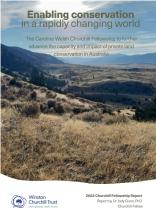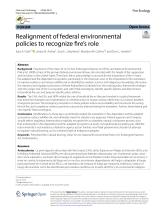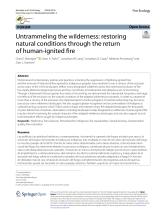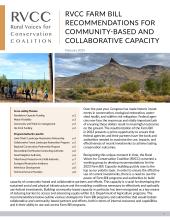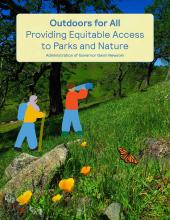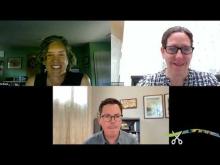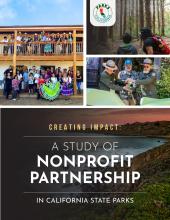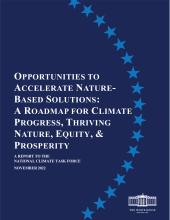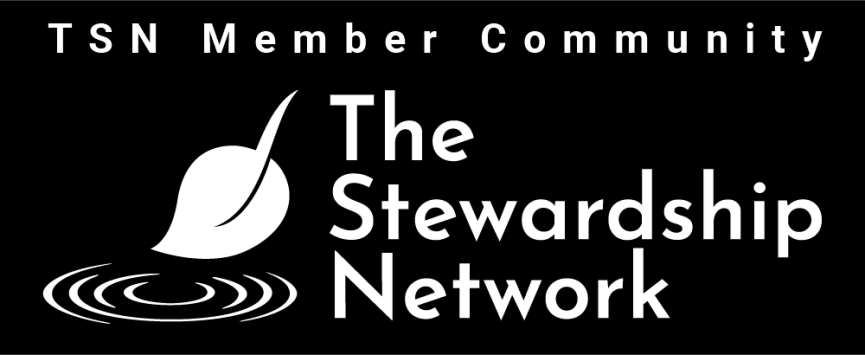Learn more about the state and national policy initiatives and funding programs that shape the work we do.
Winston Churchill Trust, May 2025
Dr. Jody Gunn's report details US/Canada conservation models, finance, and Indigenous-led strategies to scale private land conservation in Australia and combat biodiversity loss.
- Details
This report presents the findings from the 2022 Caroline Welsh Churchill Fellowship, undertaken to advance the capacity and impact of private land conservation in Australia. The Fellowship provided an opportunity to explore innovative conservation models, financing strategies, policy mechanisms, and collaboration frameworks across the United States and Canada, with the aim of applying these insights to strengthen conservation efforts in Australia.
Center for Large Landscape Conservation, September 2025
Aims to provide U.S. towns and counties with strategies, recommendations, and examples for protecting natural systems by incorporating wildlife habitat connectivity into their planning and land use decisions.
- Details
This report aims to clearly define habitat connectivity and highlight actionable strategies for integrating it into
local government planning. By incorporating habitat connectivity into policies, plans, and planning tools, local
governments can play a vital role in protecting natural systems and building healthier, more resilient communities,
now and for generations to come.The document outlines the benefits of habitat connectivity for municipalities and counties, offers practical
recommendations for incorporating ecological connectivity into local government planning and implementation,
and provides examples of plans, policies, reports, case studies, and sample language from around the country that
demonstrate how connectivity can be addressed.
University of California Berkeley, August 2024
Federal environmental laws like the CAA, ESA, and NEPA overlook fire’s ecological role. This paper urges policy reforms to support fire restoration and respect Tribal sovereignty.
- Details
Enactment of the Clean Air Act (CAA), Endangered Species Act (ESA), and National Environmental Policy Act (NEPA), three of the primary federal environmental laws, all coincided with the height of fire suppression and exclusion in the United States. These laws fail to acknowledge or account for the importance of fire in many fire-adapted and fire-dependent ecosystems, particularly in the American west, or the imperative for fire restoration to improve resiliency and reduce wildfire risk as identified by western science and Indigenous knowledge. We review the statutory and regulatory provisions of these federal laws to identify how the existing policy framework misaligns with the unique role of fire in ecosystems and with Tribal sovereignty, identify specific barriers and disincentives to beneficial fire use, and propose specific policy reforms.ion/details here.
Aldo Leopold Wilderness Research Institute, August 2024
- Details
Historical and contemporary policies and practices, including the suppression of lightning-ignited fires and the removal of intentional fires ignited by Indigenous peoples, have resulted in over a century of fire exclusion across many of the USA’s landscapes. Within many designated wilderness areas, this intentional exclusion of fire has clearly altered ecological processes and thus constitutes a fundamental and ubiquitous act of trammeling. Through a framework that recognizes four orders of trammeling, we demonstrate the substantial, long-term, and negative effects of fire exclusion on the natural conditions of fire-adapted wilderness ecosystems. In order to untrammel more than a century of fire exclusion, the implementation of active programs of intentional burning may be necessary across some wilderness landscapes. We also suggest greater recognition and accommodation of Indigenous cultural burning, a practice which Tribes used to shape and maintain many fire-adapted landscapes for thousands of years before Euro-American colonization, including landscapes today designated as wilderness. Human-ignited fire may be critical to restoring the natural character of fire-adapted wilderness landscapes and can also support ecocultural restoration efforts sought by Indigenous peoples.
California Landscape Stewardship Network, March 2023
Details a regulatory shift to streamline environmental restoration, highlighting the Cutting Green Tape initiative’s impact.
- Details
-
A paradigm shift is inherently complex and difficult to achieve. It is particularly challenging within a layered, multiagency regulatory environment that has been built over decades. However, it can be done. This case study examines one promising example—Cutting Green Tape (CGT)—that not only aims to increase regulatory and permitting efficiencies, but also to shift our collective thinking about how multibenefit environmental restoration projects in California can happen.
The CGT case study allows us to explore the evolution and current status of a perceived paradigm shift. This case study’s researchoriented lens and consideration of Kuhn’s seminal work on shifting paradigms (1970) reveals CGT’s progression in a way that can be applied by a wide range of professional audiences. Insights are shared with those seeking to create such a shift within regulatory (or similar) contexts.
Findings indicate that a paradigm shift for environmental restoration work in California is indeed underway. CGT is moving into the final phase of a five-phase process (see Five Phases of a Paradigm Shift). Two of the four signs of a true paradigm shift (see Four Signs of a Paradigm Shift) have been fulfilled, and there are initial indicators of progress towards the third sign of change as well. However, while promising, CGT as a new paradigm (i.e., a profound change in approach or underlying assumptions) has yet to be fully realized.
Rural Voices for Conservation Coalition, February 2023
Proposes capacity-building reforms to empower community-based conservation through 2023 Farm Bill programs and authorities.
- Details
-
The reauthorization of the Farm Bill in 2023 presents a prime opportunity to ensure that federal agencies and their partners have the tools and authorities needed to maximize the use, impacts, and effectiveness of recent investments to achieve lasting conservation outcomes.
Recognizing this unique moment in time, the Rural Voices for Conservation Coalition (RVCC) convened a working group to develop recommendations for the 2023 Farm Bill. Capacity-building quickly rose to the top as our priority topic. In order to ensure the effective use of current investments, there is a need to use the power of Farm Bill programs and authorities to build capacity of community-based and collaborative partners and efforts. This capacity is crucial for developing the sustained social and physical infrastructure and the enabling conditions necessary to effectively and optimally use federal investments. Building community-based capacity in particular has been recognized as a key means of reducing barriers to access and advancing equity within U.S. Department of Agriculture programs. The recommendations below outline various strategies for Farm Bill programs and authorities that would bolster collaborative and community-based partners and efforts, both in terms of internal resources and capabilities and in their ability to use and access Farm Bill programs.
California Natural Resources Agency, May 2023
Outlines actions for equitable access to parks and nature, engaging government, communities, and philanthropy statewide.
- Details
-
The Outdoors for All strategy charts progress on equitable outdoor access to date, highlights work underway, and identifies additional actions to realize the promise of a California for All. This strategy outlines pathways that government, community organizations, philanthropy, private sector, and residents across California can take together to continue increasing access to the outdoors and nature.
California Landscape Stewardship Network, September 2022
- Details
-
On September 7, 2022, the California Landscape Stewardship Network hosted the 5th virtual Cutting Green Tape Exchange. During two hours, we heard insights, updates and more on the Cutting Green Initiative from:
- Welcome from lead facilitator Shawn Johnson (University of Montana)
- Reflections on Cutting Green Tape from Wade Crowfoot (California's Secretary for Natural Resources)
- Presenting the Hidden Hero Awards to Madeline Cavalieri (California Coastal Commission) and Jake Shannon (North Coast Regional Water Board)
- SERP Program highlights and updates from Brad Henderson (California Department of Fish and Wildlife)
- Practitioners' panel on SERP Program project implementation including Kristan Culbert (American Rivers), Kellyx Nelson (California Landscape Stewardship Network), and Jim Robins (San Mateo RCD)
- News Announcement on the Programmatic USFWS Biological Opinion from Katie Haldeman (Sustainable Conservation) and Lee Ann Carranza (US Fish & Wildlife Service)
- Discussing the Cutting Green Tape Case Study with Amy Mickel (California State University at Sacramento) and Sharon Farrell (California Landscape Stewardship Network)
- Closing Reflections from Jennifer Norris (Deputy Secretary for Biodiversity and Habitat) The Exchange was facilitated by Shawn Johnson, CLSN Steering Committee member and Director at the University of Montana's Center for Natural Resources & Environmental Policy.
Parks California, Potrero Group, February 2022
Analyzes nonprofit roles in CA State Parks, showcasing best practices for impactful partnerships and visitor experiences.
- Details
-
California’s state park system encompasses 279 units of diverse resources from beaches to historic sites, to urban corridors, to vast wild areas. The system is the largest and most diverse state park system in the world, rivaling the entire national park system in many other nations. Because of this complexity, there will always be a need for the California Department of Parks and Recreation (State Parks) to embrace and maintain partnerships with many stakeholders. Propelled by State Parks’ vision and leadership, these partnerships can achieve stunning results and provide extraordinary experiences for Californians and the state’s visitors.
The California State Parks Nonprofit Partnership Study seeks to build a broad understanding of the contributions of cooperating associations, nonprofit operators and co-managers, and other nonprofit donors and program partners supporting state parks across California. The study also highlights best practices in partnership that can help parks and their nonprofit partners reach their fullest potential—together.
White House Council on Environmental Quality, November 2022
Provides five federal strategies to advance nature-based solutions for climate, equity, and economic resilience.
- Details
-
This report provides a roadmap with five strategic recommendations for federal agencies to unlock the potential of nature-based solutions and highlights bold Executive Office of the President actions designed to pave the way. Importantly, these recommendations position the United States to prioritize nature-based solutions as go-to options in fighting climate change, nature loss and inequities.
The recommendations in this report are some of the best opportunities we have to meet climate goals and grow climate-ready communities, economies, and sectors. All have a role to play in turning these recommendations into action. President Biden and his National Climate Task Force are in a position to act boldly and lead adoption of these recommendations, advancing naturebased solutions as powerful tools that the nation and the world need now.


